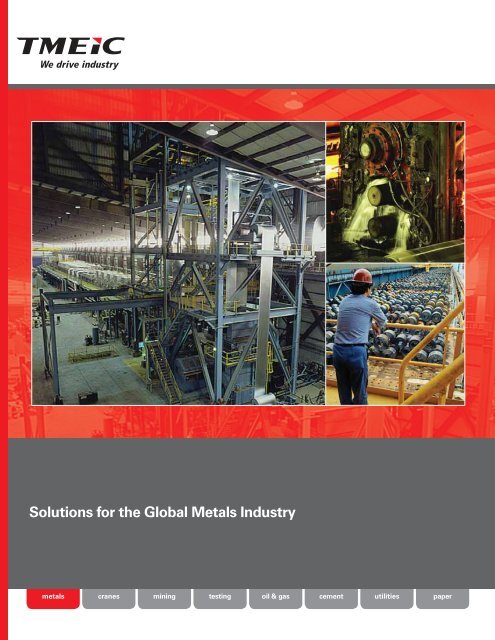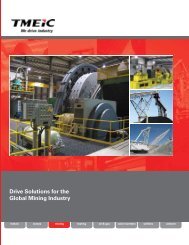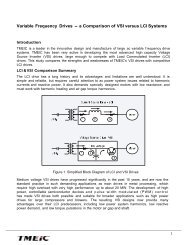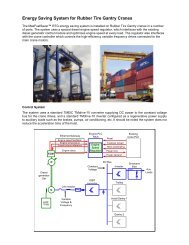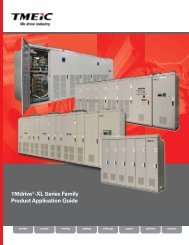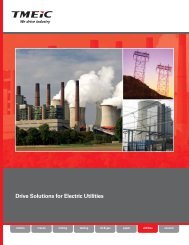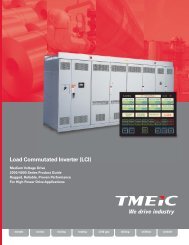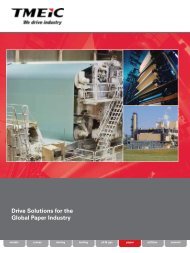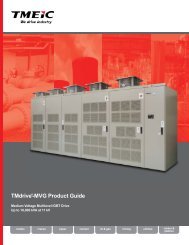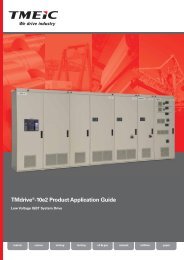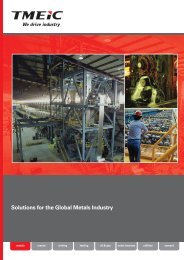Solutions for the Global Metals Industry
Solutions for the Global Metals Industry
Solutions for the Global Metals Industry
You also want an ePaper? Increase the reach of your titles
YUMPU automatically turns print PDFs into web optimized ePapers that Google loves.
<strong>Solutions</strong> <strong>for</strong> <strong>the</strong> <strong>Global</strong> <strong>Metals</strong> <strong>Industry</strong>metalscranesminingtestingoil & gascementutilitiespaper
TMEIC in <strong>the</strong> <strong>Metals</strong> <strong>Industry</strong>Worldwide Experience with all Types of <strong>Metals</strong> ProductsThe TMEIC team has been building advanced process control systems <strong>for</strong> <strong>the</strong> metals industry <strong>for</strong> over 100 years. Wehave engineered systems <strong>for</strong> all types of mills, and we have experience rolling a wide range of ferrous and non-ferrousproducts including:• Plates• Bar and rod• Strip• Galvanized products• Beams• Coated and painted productsTMEIC Covers <strong>the</strong> GlobeTMEIC has supplied thousands of drive systems around <strong>the</strong> world; some of our metals customers are listed below.The Americas Europe & Africa Asia Japan & PacificAlgomaAceros PianosAlcanAlcoaAHMSAAPMCali<strong>for</strong>nia SteelCSH (Talcahuano)CSNCSTDofascoFerrous <strong>Metals</strong>IPSCOJ & LLake Erie SteelMittal USANorth American StainlessNovelisNS BluescopeNUCOROABPhelps DodgeSeverCorrSeverstalSicartsaSteel DynamicsStelcoUPI (USS/POSCO)US SteelWeirton SteelWise AlloysAcroniAcineroxArcelorCorusErdemirGalva MetalHelenic SteelHoogovensHuta BatoryHuta CzestochowaHuta KatowiceILVAISCORMagreb TubesMMK (Magnitogorsk)RIVASeverstalSollacSSABTerniAn FengAnshangAnyangAsia AluminumBao SteelBenxiChina SteelCSACDHCEssarHandanHangzhouJen AnLian Yuan SteelMaSteelMeishanNanshan AluminumSouthwest AluminumPanzhihuaPoscoShougangShaoguanSiam Strip MillTaiyuanTangshanTonghuaUnion SteelWuhanYich PhuiAichi SteelALCOMBluescope SteelChubu KohanDaido SteelFurukawaHitachi DensenJFE SteelJLPKawasaki SteelKobe SteelMitsubishi Special MetalNakayama SteelNASCONew Zealand SteelNihon Kinzoku KogyoNikkeiNippon SteelNissin SeikoNisshinseko KureSanyo Special SteelSumitomoTokyo SteelToyo KohanPage 2 of 40© 2011 TMEIC Corporation. All Rights Reserved.
Why Our Systems Set Production RecordsThe advanced features of <strong>the</strong> TMEIC automation systemallow operation of <strong>the</strong> mill at a higher rate, often settingproduction records. In addition, we produce higherquality product, based on <strong>the</strong> superior control featuresSystem Features and Benefitsand physical models developed by our experienced metalsengineering team. The main factors providing this superiormill per<strong>for</strong>mance are outlined below.Superior Control Features Result in Higher ThroughputThe metals engineering team has developed advanced control schemes <strong>for</strong> mill operations resultingin higher mill speeds and <strong>the</strong> setting of production records.Q rad Q convAccurate Physical Models Result in a Higher Quality ProductAccurate level 2 models based on <strong>the</strong> physical processes in <strong>the</strong> rolling operation, use advancedtechniques such as finite element analysis. Models cover heat transfer, plastic de<strong>for</strong>mation, mill<strong>for</strong>ce, and mill setup, resulting in improved control and higher quality product.The Engineering Team is World ClassThe metals engineering team has many years of mill experience and has built this extensive knowhowinto <strong>the</strong> automation system and <strong>the</strong> system engineering process.The Commissioning Engineers Know <strong>the</strong> <strong>Metals</strong> <strong>Industry</strong>The commissioning engineers have years of experience in <strong>the</strong> mills and are familiar with <strong>the</strong> millmachinery and <strong>the</strong> variable speed drive systems used in automation.Micro-Tracking Allows Higher SpeedsData on <strong>the</strong> micro-tracking list is ga<strong>the</strong>red and tracked at a periodic interval of approximately 25 mm,or a fixed time, resulting in better control accuracy and improved product quality.Simple, Scalable, Open Architecture Brings Lower Cost of OwnershipThe open control architecture uses standard controllers, computers, software, and communicationinterfaces, allowing easy expansion with additional commercially available hardware and software,resulting in a lower system life-time costs.S S S Fewer Sensors Reduce CostsUsing advanced control features, <strong>the</strong> system requires fewer sensors, resulting in lower initial costand life-time maintenance cost, with an increase in ROI.+X_Unified Engineering Tools Simplify MaintenanceUnified engineering tools <strong>for</strong> configuring and tuning drives and controllers result in fastercommissioning and simplified maintenance.Robust System Diagnostics Increases AvailabilityIn-depth system diagnostics built into <strong>the</strong> engineering tools, along with <strong>the</strong> option to use remotediagnostic services, increase system availability.© 2011 TMEIC Corporation. All Rights Reserved.Page 3 of 40
Total <strong>Solutions</strong> <strong>for</strong> Mill AutomationHot Mills Page 7Advanced Control Features Section Page• Shape setup• Object oriented softwaredesign and programming• Highly integrated level 1& 2• Automatic gage control• Eccentricity control• Automatic profile &flatness control• Flying gage change (FGC)• Slab sizing press setup• Dual mode rolling setup(austenitic and ferritic)• Dual mill mode setup(Semi-continuous & batchoperation)• Lubricated rolling• Material propertiesprediction• Ultra-light gage modeling• Thermo-mechanical rolling• Plate pattern optimization• Dual phase/Interruptedcooling• Piece sample tracking• Fast FM thread• Multi-mode coiling controlCaster & FurnaceControl .......................7Slab Sizing Press &Roughing Mill ............8Edge & Bar InductionHeaters ......................9Finishing Mill ........... 10Coiling TemperatureControl ..................... 11Coiler Control ..........12Steckel Mill ..............13Flying Gage Change 14Material PropertiesPrediction System ...15Cold Mills Page 16Advanced Control Features Section Page• Cold mill setup• Shape setup• Object-oriented level 2 design and programming• Highly integrated level 1 and 2• Automatic gage control• Eccentricity control• Automatic profile and flatness control• Flying gage change (FGC)• Differential tension controlFast & EffectiveLevel 1 Controls ......16Integrating Models<strong>for</strong> Superior Control 17Process Lines Page 18Advanced Control Features Section Page• Product tracking• Weld/seam tracking• Heated/tail tracking <strong>for</strong> entry/exit automation• Minimum tension control• Maximum tension control• Optimized bridle load distribution• Elongation control (leveler & skin pass mills)• Loss compensation• Position control• Line setup• Setpoint distribution• Data acquisition• Open loop feed-<strong>for</strong>ward tension controlTMEIC’s Approach toProcess LineAutomation .............18Designing <strong>the</strong> StripTransport ControlSystem ..................... 19Implementing <strong>the</strong>Open Loop Feed-Forward Control ...... 19Page 4 of 40© 2011 TMEIC Corporation. All Rights Reserved.
Total <strong>Solutions</strong> <strong>for</strong> Mill AutomationLong Products Page 20Advanced Control Features Section Page• Product tracking• Mill pacing• Flexible rolling & coolingschedules• Roll & bearingmanagement• Minimum tension control• Accurate shear control• Cascade speed controlRod Mills:• Sizing block control• Precision laying headcontrol• No Twist Mill controlSection Mills:• Saw management systemsRod Mills ..................20Section Mills ............21Product Tracking &Machine Monitoring 21Modernization Page 225TouchScreenHMI6DCS networkinterfaceInnovation ControllerCPL or Series Six I/O BusSiltronHardwiredoperatordevicesM4I/OSiltronMTM-DC DigitalFront End (DFE)DMC or Series SixMaster ControllerSiltronM123TM-DC ModuleAssemblyTM-SeriesAC DriveAdvanced Control System Upgrades Section PageTMEIC’s control system is a scalable, open architecture readilyallowing future expansion and modernization.Legacy mill control systems are easily upgraded to <strong>the</strong> latesthardware and software.1970’s LegacySystem .....................22Early 1980’sLegacy System ........23Late 1980’sLegacy System ........24Early 1990’sLegacy System ........25Non-TMEIC System 26Services Page 27World Class Mill Automation Section Page• World-class process and automation specialists <strong>for</strong> <strong>the</strong>metal rolling and metal strip processing industries• Years of experience• Broad process knowledge• Project management skills.• Engineering team is supported by world-classcommissioning and field service personnel.Engineering Team ...27Technical Proposal ..28Design andProcurement ............29Factory SystemTest 30SystemCommissioning, .....32Training &Documentation .......32Maintenance &Service .....................33Products Page 35Products Section PageThe family of drives covers <strong>the</strong> power and supply voltagerequirements <strong>for</strong> new and legacy systems.Panel-mounted touch stations, pulpit HMIs, and level 1 and 2system software provide <strong>for</strong> all operator and control needs.AC/DC SystemDrives .......................35Operator Interfaces .36Software Toolsand Utilities .............37Mill Level 2 andModels .....................39© 2011 TMEIC Corporation. All Rights Reserved.Page 5 of 40
Hot MillsTMEIC has many firsts in hot mill automation, including <strong>the</strong> first use of all AC main drives, <strong>the</strong> first computer-based hot millsetup, and <strong>the</strong> first and only implementation of semi-continuous rolling in a hot mill. Our Team has installed over 140 majorbeam, plate, and hot mill systems worldwide. This section discusses TMEIC’s advanced hot mill control system.Caster & Furnace ControlCaster control includes precise mold level control and close drive coordination <strong>for</strong> various types ofcasting machines. Several furnace control functions are closely coordinated to maximize production,and minimize fuel consumption and <strong>the</strong> <strong>for</strong>mation of scale on <strong>the</strong> slab.Slab Sizing Press & Roughing MillThe slab sizing press tailors <strong>the</strong> width of each slab, and <strong>the</strong> roughing mills reduce <strong>the</strong> thickness to<strong>the</strong> particular order, based on inputs from <strong>the</strong> roughing mill models.Edge & Bar Induction HeatersThe edge heater and <strong>the</strong> bar heater produce a uni<strong>for</strong>m temperature across and along <strong>the</strong> bar be<strong>for</strong>eit enters <strong>the</strong> finishing mill.Finishing MillThe bar’s identity, temperature, thickness, and width are sent via <strong>the</strong> finish mill tracking function tosetup models, which calculate a set of references <strong>for</strong> <strong>the</strong> control functions.Coiling Temperature ControlTo produce required mechanical properties, such as tensile strength and elongation, <strong>the</strong> rate ofcooling and final temperature of <strong>the</strong> strip as it enters <strong>the</strong> coilers is precisely controlled.Coiler ControlThe coiler setup feeds references to <strong>the</strong> master controller, which <strong>the</strong>n distributes <strong>the</strong>m to <strong>the</strong>appropriate coiler controller <strong>for</strong> application.Steckel MillControls <strong>for</strong> <strong>the</strong> Steckel coiling furnaces and rolling mill are coordinated and optimized <strong>for</strong> all passes.Flying Gage ChangePrecise mill control allows <strong>for</strong> different product to be made continuously from one long slab.Material Properties Prediction SystemThe computerized system improves <strong>the</strong> microstructure prediction accuracy of hot rolled steel.Page 6 of 40© 2011 TMEIC Corporation. All Rights Reserved.
Caster & Furnace ControlCaster ControlFurnace ControlCaster Operator’s Overview ScreenTMEIC’s automation and control of <strong>the</strong>entire hot mill starts with <strong>the</strong> businesscomputer download of <strong>the</strong> mill schedule<strong>for</strong> <strong>the</strong> new ladle. The individual castercontrol functions include:• Ladle handling• Tundish level control• Mold level control and moldcooling• Cooling spray water flow control• Coordinated drive controlincluding anti-sag feature• Width control and shear control• Strand trackingFor <strong>the</strong> contents of each ladle, completeproduct tracking begins, and a coordinatedsystem of reference distribution is carriedon to <strong>the</strong> finished coil. The data collectedand distributed includes <strong>the</strong> chemicalproperties of <strong>the</strong> steel, <strong>the</strong> mechanicalproperties, and <strong>the</strong> product dimensions.The furnaces maintain a steady delivery of temperature-controlled slabs to <strong>the</strong> mill. The main automation objectives areto maximize production, minimize fuel consumption, and reduce scale <strong>for</strong>mation.TMEIC differentiates its furnacecontrol by integrating physical modelswith <strong>the</strong> furnace control functions.Product Data In<strong>for</strong>mation (PDI) comesfrom <strong>the</strong> business computer overE<strong>the</strong>rnet.Mill Pacing FunctionLevel 2 mill pacing uses PDI data andtracking data to calculate <strong>the</strong> optimumextraction time. It is also coordinatedwith <strong>the</strong> reheating furnace control (in<strong>the</strong> figure <strong>the</strong> white furnace controlblocks may be provided by <strong>the</strong> furnaceOEM).BUSINESSCOMPUTERSLAB PDI DATAMODELSMILL PACINGTRACKINGFURNACEMODELSROUGHING MILLSETUPFURNACEMODELSREHEATTEMPERATUREFEEDBACKRMTEMPERATURESFEEDBACKZONETEMPERATURESCONTROLCHARGE &EXTRACTBURNER CONTROLBURNERMANAGEMENTFURNACE CONTROLZONETEMPERATURESENSORSFURNACERoughing Mill SetupLevel 2 model provides roughingmill setup data and interfaces to <strong>the</strong>furnace control.FEEDBACKPROCESSINGTIMESREHEATFURNACESENSORSROUGHINGMILLSlab TrackingLevel 2 mill tracking function is linkedto <strong>the</strong> mill tracking and pacing.SENSORSFINISHINGMILL© 2011 TMEIC Corporation. All Rights Reserved.Page 7 of 40
Slab Sizing Press & Roughing MillThe slab sizing press and roughing mill reduce <strong>the</strong> widthand thickness of <strong>the</strong> slab in preparation <strong>for</strong> <strong>the</strong> finishingmill. With a large width reduction, <strong>the</strong> slab sizing presstailors each slab to a particular order. The roughing millmodels provide <strong>the</strong> target width reduction to <strong>the</strong> level1 controller, which takes each slab to this desired widththrough a series of press actions. The press is electricallydriven by a large medium voltage motor and drive.Hydraulically driven top and bottom hold down rollsprevent buckling of <strong>the</strong> slab. Width gauges at <strong>the</strong> pressentry and at <strong>the</strong> roughing mill exit validate that <strong>the</strong> targetwidth is achieved. The entire process is monitored byoperators on HMI screens.Significant Improvements to Operation of <strong>the</strong> Slab Sizing Press & Roughing MillAdvanced features of <strong>the</strong> TMEIC system includeimproved caster efficiency, increased mill widthreduction capability, improved width uni<strong>for</strong>mity, andimproved control tolerances. Control features includemicro-tracking (fast tracking) of slab position and speed,per<strong>for</strong>med <strong>for</strong> <strong>the</strong> position and pressure regulators.The advanced sizing press model calculations include:• Die gap calculations <strong>for</strong> <strong>the</strong> anvil control• Head, body and tail draft calculations <strong>for</strong> widthreduction• Hold down roll <strong>for</strong>ce calculations <strong>for</strong> buckleprevention• Pre<strong>for</strong>ming length calculations <strong>for</strong> <strong>the</strong> taperedsections• Table lift calculations to compensate <strong>for</strong> increasingslab height• Slab elongation ratio and travel time calculationsSlab Sizing PressRoughing MillThe roughing mills (RM) reduce <strong>the</strong> width and thickness of <strong>the</strong> bar. They can bereversing, continuous, or a combination of both.Roughing Mill ScreenSlab Tracking RM ModelsControl starts with <strong>the</strong> level 2 slab tracking function, directing <strong>the</strong> level 1 sequencingand regulators based on which zone <strong>the</strong> slab is in. Hot metal detectors and o<strong>the</strong>rsensors are used to define <strong>the</strong> zone transitions. Specific mill references distributedfrom <strong>the</strong> tracking and set-up models include:• Horizontal roll positions, side guide positions, and RM speeds• Vertical roll positions and draft compensations <strong>for</strong> <strong>the</strong> RM edgers• Spray selection <strong>for</strong> each of <strong>the</strong> millsDynamic References <strong>for</strong> Roughing MillAfter leaving <strong>the</strong> sizing press, <strong>the</strong> slab travels through <strong>the</strong> universal roughing millstands where <strong>the</strong> width is fur<strong>the</strong>r controlled by <strong>the</strong> edger drafting. Prior to each pass,<strong>the</strong> level 2 set-up model provides a new set of references to <strong>the</strong> mill.Reversing Mill ScreenLooperless Tension Control Between Close Coupled Tandem Roughing StandsClose coupled roughing stands fur<strong>the</strong>r reduce <strong>the</strong> width and thickness preparing <strong>the</strong>slab <strong>for</strong> <strong>the</strong> finishing mill stands. Low tension control is applied between <strong>the</strong> closecoupled stands including coupled edgers.Page 8 of 40© 2011 TMEIC Corporation. All Rights Reserved.
Edge & Bar Induction HeatersInduction heating is a fast and efficient method of heating moving metal, and it has been applied to various metalprocessing lines. TMEIC has applied large capacity induction heaters to hot strip mills since 1984. They are used <strong>for</strong> edgeheating and bar heating to obtain uni<strong>for</strong>m temperature be<strong>for</strong>e <strong>the</strong> bar enters <strong>the</strong> finishing mill, and have been installed onmany new hot strip mills in recent years.Three types of induction heaters are available:Solenoid TypeThis type has a flat heating characteristic, used inhot strip mills <strong>for</strong> bar heating.Transverse TypeThis type has a partial heating characteristic andhas been used <strong>for</strong> bar center heating.C-shape Transverse TypeThis type has high heating efficiency and is used<strong>for</strong> edge heating.Solenoid Type Bar Heater- Power level: up to 9,000 kW- Inductor frequency: 1,400 Hz- Temperature rise: 40°CC-Shape Transverse Type Edge Heater- Power level: up to 4,000 kW- Inductor frequency: 300 Hz- Temperature rise: 50°CTemperature [Deg.C]1120110010801060104010201000980960BAR TEMPERATURE CURVEBAR TEMPERATURE CURVE (Hot Bar 1730 mm - 40 mm T)0 1 2 3 4 5 6 7 8 9 10 11 12 13 14 15 16 17 18DistanceAverageCenter-CenterCenter-SurfaceEdge-CenterEdge SurfaceBar Heating Temperature SimulationBe<strong>for</strong>e <strong>the</strong> edge heaters, <strong>the</strong>temperature differential between <strong>the</strong>bar edge and <strong>the</strong> center is about 50º C.After <strong>the</strong> bar heaters, <strong>the</strong> temperaturedifferential has been reduced to about10º C.EDGE EDGEHEATER HEATER1EDGEHEATER2BARHEATER1BARHEATER2SIDE GUIDECROP SHEAR© 2011 TMEIC Corporation. All Rights Reserved.Page 9 of 40
Finishing MillUsers require strip with close dimensional tolerances and exact metallurgical properties. TMEIC’s control system usesmodels based on physical and material behavior to set up <strong>the</strong> level 1 controls <strong>for</strong> <strong>the</strong> desired strip width, gauge, shape,tension speed, and temperature.Mill Setup Model Includes:Strip Thickness ModelThe finish mill setup model providesinputs to <strong>the</strong> level 1 roll gap absolutegage control.Strip Width ModelModels <strong>for</strong> exit spread, edging draft,and width reference provide inputs to<strong>the</strong> RM setup and level 1 automaticwidth control.Temperature & SpeedThe temperature setup model (notillustrated here) provides inputs to<strong>the</strong> cooling spray controls and <strong>the</strong>main drive speed.Shape ModelThe shape setup model providesinputs to <strong>the</strong> level 1 automatic stripprofile control, <strong>the</strong> automatic stripflatness control, and roll shiftingusing ei<strong>the</strong>r <strong>the</strong> Continuously VariableCrown or Pair Cross systems (notillustrated here).Dual Mode Mill Setup has a combinedfunctionality of level 2 models<strong>for</strong> finishing mills and slab setupcalculations <strong>for</strong> one (batch mode)or more products (semi-continuousmode) in <strong>the</strong> slab.Q radiationQ radiation43210Q conductionQ convectionQ conductionQ convectionSlap/Strip Heat Transfer Model <strong>for</strong> RM,FM, and Coiling Temperature ControlFM Strip Thickness (FM Models)OPERATORINPUTSDESIREDTHICKNESSMODELSHOLDINGTABLETRANSFERFM EXITVERNERFM Strip Width (RM Models)OPERATOR INPUTS: FINISH WIDTH OFFSET EDGER LOAD DISTRIBUTIONHARDNESS &DEFORMATIONFEEDBACKMASS FLOWTHICKNESSMODELSFINISH MILLTEMPERATURESETUPMODELSFINISH MILLTEMPERATURESETUPFEEDBACK FEEDBACK FEEDBACKMODELSEDGING DRAFTDISTRIBUTIONMODELSWIDTHREFERENCECONTROLAUTOMATICWIDTHCONTROLTEMPERATUREMODELSEXIT SPREADFEEDBACKEXIT SPREADFEEDBACKFEEDFORWARDFEEDBACKHEAD & BODYMONITORCONTROLROLL GAP &ABSOLUTEAGCCONTROLFASTADAPTIVETHREADFEEDBACKGAGEMETERTHICKNESSFEEDBACKEXIT VERNIERTemperature SetupSpeed SetupShape SetupSENSORSROLLFORCESENSORSROLL GAPSENSORSMILLSPEEDSENSORSTHICKNESSSENSORSEXITWIDTHSENSORSFORCEPROFILESENSORSWIDTHPROFILEFINISHING MILLSetup ModelsUsing roughing mill exit data, models calculate references:• A roll gap position, speed, and roll bending reference <strong>for</strong> each stand• Tension and position references <strong>for</strong> each of <strong>the</strong> inter-stand loopers• Position references <strong>for</strong> <strong>the</strong> finishing stand side guides and roll shifting• X-Ray gauge thickness and alloy compensation values• A reference <strong>for</strong> <strong>the</strong> bar’s exit width, gauge, and temperature• Finish mill speed-up rate and limit• A set of automatic gauge control predicted <strong>for</strong>ces and transfer functions• Inter-stand cooling spray patterns and flow references from <strong>the</strong> outputs of<strong>the</strong> temperature modelPage 10 of 40© 2011 TMEIC Corporation. All Rights Reserved.
Coiling Temperature ControlSteel customers today demand that mills produce specific mechanical properties <strong>for</strong> <strong>the</strong>ir products, such as yield strength,tensile strength, and elongation. The coiling temperature control maintains <strong>the</strong> rate of cooling and <strong>the</strong> final temperature(<strong>the</strong> temperature-time profile) of <strong>the</strong> strip to obtain <strong>the</strong> desired metal properties as it enters <strong>the</strong> coilers.TMEIC’s Coiling TemperatureControl (CTC) features:Physics-based ModelsThe model of <strong>the</strong> coolingprocess generates coolingwater flow setpoints,which are sent to <strong>the</strong> level1 control to produce <strong>the</strong>desired temperature-timeprofile as <strong>the</strong> strip movestoward <strong>the</strong> coilers. A processmodel encompasses variouscoiling temperature controlstrategies.Metallurgical-based ModelsThe CTC model includes<strong>the</strong> effects of <strong>the</strong> steelphase trans<strong>for</strong>mation <strong>for</strong>accurate prediction of <strong>the</strong>temperature-time profilerequired <strong>for</strong> <strong>the</strong> optimummechanical properties.MODELSSTRIP SPEEDPROFILEMILL EXITSENSORSTRACKINGPIECE SAMPLEFEEDBACKIN-COILFEEDFORWARDFINISHINGSPEEDSENSORSFM EXITTEMP.EARLY COOLINGZONEMODELSCOILINGTEMPERATUREFEEDBACKIN-COILFEEDBACKINTERMEDIATECOOLING ZONEFEEDBACKFEEDBACKSYSTEMPARAMETERSIN-COILFEEDFORWARDS ENSORSBOTTOMPYROTRACKINGPIECE SAMPLEMODELSCOILINGTEMPERATUREFEEDBACKIN-COILVERNIERSENSORSBOTTOMPYROSENSORSCOILINGTEMP.LATE COOLINGZONE - VERNIERCoiler Temperature Control SystemEarlyCoolingDUAL PHASE COOLINGRadiationLateCoolingDetails of <strong>the</strong> Coiling Temperature Control ModelThe rate of cooling, <strong>the</strong> intermediate, and final temperature, are tied to<strong>the</strong> desired mechanical properties, thus precise cooling control is critical.TMEIC’s Dual Phase Cooling model illustrated above is described here.Early Coiling Temperature Cooling ModelThe CTC model takes finishing mill exit speed and temperature plus feedback from <strong>the</strong> intermediate zone and calculates<strong>the</strong> level 1 cooling water flow setpoints <strong>for</strong> <strong>the</strong> early cooling zone to achieve <strong>the</strong> desired quench rate and intermediatetemperature.Dual Phase/Interrupted CoolingThe combination of interrupted cooling and modeling of low target temperatures achieves specific steel structures such as<strong>the</strong> bainitic and martensitic.Late Coiling Temperature Cooling ModelThis model takes <strong>the</strong> final and intermediate temperatures and calculates <strong>the</strong> late (vernier) cooling flow setpoints. Thecoiling temperature control model utilizes several techniques including feedback, feed<strong>for</strong>ward, and vernier temperaturecontrol to meet <strong>the</strong> process objectives.© 2011 TMEIC Corporation. All Rights Reserved.Page 11 of 40
Coiler ControlCoiler technology has advanced over<strong>the</strong> last ten years bringing many newfeatures including:• Various coiler side guidesoperating and coiling modes• Various coiler pinch roll gapoperating and coiling modes• Various wrapper roll gapoperating and coiling modesTMEIC provides advanced level 1controls to support <strong>the</strong>se new features.This page describes how a typicalnew automatic coiler operates. Theoperator HMI screen shows real timedata with animated coiler graphics.Coiler Operator ScreenCoiler MachineCoiler Control Functions Deliver Completely Automated OperationSetup References Sent From ModelsCoiler operation starts with <strong>the</strong> associated setupfunction feeding several references to <strong>the</strong> level 1 controlpreparing <strong>for</strong> a given coil. The coiler master referencecontrol function <strong>the</strong>n distributes <strong>the</strong>se references to <strong>the</strong>appropriate coiler controller <strong>for</strong> application.Hydraulic Jump ControlInitially, <strong>the</strong> unit rolls are positioned to a pre-set gap.As <strong>the</strong> strip passes by <strong>the</strong> roll, it applies a pre-set <strong>for</strong>ce,bending it around <strong>the</strong> mandrel. To avoid marking <strong>the</strong>strip, <strong>the</strong> rolls jump clear of <strong>the</strong> strip head as it passesunder each roll. This is commonly called automatic jumpcontrol. When <strong>the</strong> strip is tight around <strong>the</strong> mandrel, <strong>the</strong>unit rolls are retracted.Tail-end Slow Down and SpottingThere is a strip position calculator and tail-end spottingfunction that calculates <strong>the</strong> position of <strong>the</strong> strip’s tail-endas it progresses down <strong>the</strong> run-out tables and computes<strong>the</strong> slow-down point <strong>for</strong> <strong>the</strong> end of <strong>the</strong> coil.Telescoping ControlAno<strong>the</strong>r function in modern coiler systems is <strong>the</strong> coilpresentation or telescopicity control. This is accomplishedwith sophisticated multi-mode hydraulic regulators on<strong>the</strong> entry side guides and stepless mandrel expansioncontrol.Completely Automated Coil DeliveryAt <strong>the</strong> output of <strong>the</strong> coiler control system, each of <strong>the</strong> coilsis automatically:• Banded• Weighed• Inspected by <strong>the</strong> shape meter• Marked <strong>for</strong> shipmentThe overhead crane <strong>the</strong>n moves <strong>the</strong> finished coils to <strong>the</strong>storage area.Page 12 of 40© 2011 TMEIC Corporation. All Rights Reserved.
Steckel MillThe Steckel mill is a unique type of reversing rolling mill,which can roll very large slabs to produce high qualityplate and strip. Furnaces on both sides of <strong>the</strong> mill provideheated space to store <strong>the</strong> increased length of coiledmaterial produced during strip rolling. These coilingfurnaces allow <strong>for</strong> additional heat retention and <strong>the</strong>rmalconsistency in <strong>the</strong> rolled piece, which in turn producesimproved uni<strong>for</strong>mity throughout <strong>the</strong> rolled product.Steckel Mill with Coiling Furnaceslocated on ei<strong>the</strong>r sideOn right - Operator’s Screen showing:- Alarms & Manual Control buttons- Steckel Mill graphic- Real-time data- Screen navigation buttons at <strong>the</strong> bottomWorld Class Features of TMEIC’s Steckel Mill Control SystemTriple Adaptive ModelThe model contains three separate control setups <strong>for</strong><strong>the</strong> head, body, and tail of <strong>the</strong> slab.Wide Product RangeControls can handle rolling both plate and coil withthicknesses from 1 mm to 70 mm, with complexsequences and auto recovery from manual intervention.Pass to Pass AdaptationAll critical material parameters are measured and <strong>the</strong>control setup calculated <strong>for</strong> <strong>the</strong> next pass.Tapered Thickness RollingThe thickness is fully programmable so that <strong>the</strong> headand tail can be reduced to a different amount than <strong>the</strong>body. Uni<strong>for</strong>m thickness is produced in <strong>the</strong> final pass.Absolute Hydraulic Automatic Gage ControlThe AGC works to achieve constant target thicknessand/or follow a predetermined thickness trajectory.Temperature Controlled RollingThe metal temperature is controlled so <strong>the</strong> desiredmechanical properties can be achieved.Coiling Furnace Temperature ModelThe temperature model calculates <strong>the</strong> heat transfer to<strong>the</strong> coil in <strong>the</strong> furnace.Finishing Temperature ControlThe model calculates <strong>the</strong> desired speed of each passbased on <strong>the</strong> target temperature in <strong>the</strong> coil body.Coiling Temperature ControlThe run out table sprays are controlled to produce <strong>the</strong>temperature-time profile <strong>for</strong> <strong>the</strong> desired metallurgicalproperties.© 2011 TMEIC Corporation. All Rights Reserved.Page 13 of 40
Flying Gage ChangeThis page gives an overview of an advanced control technology applied to hot strip mills producing light and ultra-lightgage strip. These mills work with long slabs and produce many coils of various thicknesses from one slab. Flying gagechange (FGC) technology is used to change <strong>the</strong> strip thickness.The diagram shows three products A, B, and C continuouslyrolled from one slab without de-threading strip from <strong>the</strong>stands. In <strong>the</strong> case of a hot mill, <strong>the</strong> mill cannot be sloweddown to make changes, so FGC is a highly coordinatedcontrol procedure involving multiple process actuators. Thefirst semi-continuous hot mill FGC system, implemented byTMEIC, was in 2000.CoilA-1CutPointCoilA-2CutPointCoilA-3CutPointCoilB-1CutPointCoilC-1Product A Product B Product CThe level 2 models, which control and optimize this change, as well as <strong>the</strong> mill functions affected, are shown below.TFTCCasterShearTUNNEL FURNACETEMPERATURECONTROLTunnelFurnaceCropShearFSBEdgerRTWROLLTEMPERATUREAND WEARSSUSHAPESETUPDMMSDUAL MODEMILL SETUPFDTCFINISHING DELIVERYTEMPERATURECONTROLOptional CoilerF1 F2 F3 F4 F5 F6 F7HighROTSpraysCOILINGTEMPERATURECONTROLSpeedShearCTCRotaryCoilerROTSpraysCoilerTunnel FurnaceTemperature Set-pointsExtract TimeDescale Flows SetupStand Strip exit thicknessStand SpeedMill Spray FlowsLooper TensionRoll ForceLead SpeedDual Mode MillEdge draftHead & Tail AWC ref'sRoll profile actuator positionvs. bending transfer functionsScans scheduleRoll ShiftRoll BendingRunout TablesSpray ActionsTMEIC has implemented two types of FGC:Type 1. Constant Finishing Mill Exit SpeedWith this strategy, <strong>the</strong> mill speed is raised to <strong>the</strong> targetlevel prior to <strong>the</strong> transition, <strong>the</strong>n <strong>the</strong> gap and up-millstand speeds are transitioned using a ramp. During <strong>the</strong>change, <strong>the</strong> looper, speed, gap, and profile adjustmentsare tracked and tightly controlled, and <strong>the</strong> finishing millexit speed is held constant.Type 2. Constant Finishing Mill Exit Strip Mass FlowWith this strategy, control of strip speed at <strong>the</strong> run-outtable and exit mass flow control are required. The gapand stand speeds are progressively transitioned downmillusing a ramp. The looper, speed, gap, and profileadjustments are tracked and tightly controlled, and <strong>the</strong>finishing mill entry speed is held constant.Page 14 of 40© 2011 TMEIC Corporation. All Rights Reserved.
Material Properties Prediction SystemMaking High-Strength Steels at Lower CostSteel researchers are continually developing high-strength rolled steels <strong>for</strong> applications such as automobile bodies. A wayto predict <strong>the</strong> microstructure and mechanical properties of <strong>the</strong>se steels would allow <strong>the</strong> production of fine grain size withhigh strength using lower grade metal. Only small quantities of additional alloying elements would be required.An integrated system combining simulation of <strong>the</strong> hot rolling process withprediction of <strong>the</strong> microstructure of <strong>the</strong> hot rolled steel has been developed byTMEIC, enabling <strong>the</strong> development of new production processes <strong>for</strong> fine grain sizesteel. The system has been proven in predicting grain size.The two steel micrographs shown here illustrate coarse grain structure (lowstrength) and fine grain structure (high strength).Course GrainStructureFine GrainStructureThe Material Properties Prediction System has Two Main PartsRolling Process Modeling SystemThis system evaluates rolling <strong>for</strong>ce, torque, power, etc., using equations modeling <strong>the</strong> rolling process. The calculation usesnumerical methods and is based on a specified distribution of roll <strong>for</strong>ces and temperatures among <strong>the</strong> stands.Rolled Steel Microstructure Prediction SystemThis system per<strong>for</strong>ms metallurgical calculations taking into account <strong>the</strong> rolling and subsequent cooling processes. Theprocess phenomena include static and dynamic recrystallization, grain growth, and <strong>the</strong> austenite-ferrite trans<strong>for</strong>mation.Typical Prediction ResultsFinisherLaminarCoolingTemperature1050-grainCASE -B750 -grainCASE-A680880 De<strong>for</strong>med- grainFerrite+pearlite structure720640Sub- grainsin- grain Fine ferrite+pearlite structureTimeEffect of Rolling & Cooling on Grain StructureTransition of austenitic graindiameter with de<strong>for</strong>mation.Upper plot 850°, Lower 950°C.Transition of volume fractionin each structure withde<strong>for</strong>mation.Upper plot 850°, Lower 950°C.© 2011 TMEIC Corporation. All Rights Reserved.Page 15 of 40
Cold MillsTMEIC has automated over 100 cold mills worldwide. This vast experience includes controls <strong>for</strong> tandem mills, single andmulti-stand reversing mills, temper mills, and Sendzimir mills. TMEIC’s automation system provides superior control basedon accurate process models and tightly integrated level 1 control. Some examples are illustrated here.Tandem MillFast and Effective Level 1 ControlsCoordinationCoordinated in-coil adjustments use measured andcalculated values to maintain targets.Automatic Gage ControlAutomatic Gage Control (AGC) employs mass flowcalculation, feed<strong>for</strong>ward, feedback, tension, and slipcompensation.EccentricityEccentricity control reduces <strong>the</strong> effect of backup rollirregularities on thickness using Fourier Series Analysis.Single Stand MillAutomatic Flatness ControlAdvanced data filtering, parabolic flatness control, tiltcontrol, segmented coolant spray control, and shapemaintenance.Flying Gage ChangeFast coordinated control changes minimize strip breaksand mass flow disturbances.Micro-trackingHigh-speed data acquisition and tracking allows fasterand more accurate control action.GageDeviation[um]50Last Last Stand stand Exit exit FGC taper length < 5m < 5m-5050EccentricityOutput[um]Switch EccentricityControlControloffoffThickness [um]-500 10 20 30TimeResults of Eccentricity Control Time (sec)Fast Flying Gage Change ControlPage 16 of 40© 2011 TMEIC Corporation. All Rights Reserved.
Integrating Models <strong>for</strong> Superior ControlTMEIC’s automation system provides superior cold mill control based on accurate level 2 process models and integratedlevel 1 controls. Some process models are listed below along with <strong>the</strong> shape control block diagram.Level 2 Process Models Ensure Production of Quality ProductForce and Power ModelsForce, torque, and power modelswith <strong>the</strong> effects of tension andfriction.Flow Stress ModelsFlow stress models with <strong>the</strong>material chemistry and workhardening effects on elongation.Friction ModelsCompensation <strong>for</strong> coefficient offriction variations.Strain ModelIn-coil strain distribution.Thermal and wear effects on rolldiameter profile.InteractionsInteractions between tension,<strong>for</strong>ward slip, friction, and speed.Textured RollsThe coefficient of friction effectof textured rolls.Product VariationsProduct dependent transferfunctions <strong>for</strong> level 1 control.De<strong>for</strong>medRollRadiusEntryThicknessEntryTensionRollRadiusMetal De<strong>for</strong>mation ModelRollForceExitThicknessNRollForceDe<strong>for</strong>mationPowerPressure due toroll-strip frictionExit TensionRoll Wear ModelPressure due tometal de<strong>for</strong>mationresistanceReferences from <strong>the</strong> model provide <strong>the</strong> setup <strong>for</strong>level 1 controls, as shown in <strong>the</strong> diagram below.ShapeControlBlockDiagramOperatorRB AdjustRoll Side-ShiftPositionModelCMSetupModelThread/RunFeedbackFlatnessFeedbackType of RollBending andShiftRoll ForceRollContourModelRollWearModelRollThermalModelGround Roll CrownStack Crown VerniersStripTensionRollDeflectModelModelStripBucklingModelStrip PropertiesProfileVernierPDI EntryProfileRoll profileactuatorBucklingThresholdModelRoll GapContourPhysicalModelModelStripPhysicalModelRollGapCrownStrip Recalculation <strong>for</strong> Limit ConstraintsPass #Max/Min Roll Gap CrownsStripStrainRangePassConstraintsStrip ConstraintsPass #Per Unit Profile andStrip ConstraintsNo TensionThreadRunModelStripFlatness&ThicknessStrategy1. Run Condition2. Mill Fully Threaded3. Post Entry ThreadFlatnessRoll SensorBending &ShiftingReferencesControlClosed LoopFlatnessControl© 2011 TMEIC Corporation. All Rights Reserved.Page 17 of 40
Process LinesIn recent years, changes in strip processing line mechanicalconfigurations and increasing customer expectations <strong>for</strong>strip quality and line productivity have combined tocreate demands on <strong>the</strong> capabilities of electrical drive andcontrol systems. TMEIC has responded with an approachthat addresses <strong>the</strong> unique requirement of effectivestrip transport in strip processing line applications. Thebenefit to customers is a level of per<strong>for</strong>mance that cansupport high line speeds and a broad range of productsprocessed on a single line. In addition, TMEIC helpsinsure a level of per<strong>for</strong>mance that eliminates strip breaks,bridle slippage, furnace necking, catenary scratching, ando<strong>the</strong>r per<strong>for</strong>mance problems that result in degradation offinished strip quality.TMEIC’s Approach to Process Line AutomationFor superior process line control, it must beunderstood that <strong>the</strong> main function of <strong>the</strong> controlsystem is to provide effective strip transportunder all line operating conditions. To achievethis, TMEIC:• Analyzes <strong>the</strong> line control in terms of <strong>the</strong>power required by <strong>the</strong> strip transportequipment, <strong>the</strong>n models <strong>the</strong> line in terms ofpower elements:a. Power source – positive motor torqueb. Power sink – negative motor torque• Applies an understanding of <strong>the</strong> powerrequirements <strong>for</strong> each strip transportmachine to create a control system based ona feed <strong>for</strong>ward tension referencing systemthat minimizes dependency on closed loopregulator per<strong>for</strong>mance.ENTRY ACCUMULATORPAYOFFREELPINCH ROLL(THREAD ONLY)FLATTENER PRE-CLEANER#1 BRIDLERINSE#2 BRIDLE #3 BRIDLEKG/mm^2TENSION ZONE 1#1 BRIDLEENTRY TENSIONTENSION ZONE 2 TENSION ZONE 3#2 BRIDLEENTRY TENSION(ZONE 1 BASE)FLATTENERLOSSESCLEANINGLOSSESNORMALIZEDACCUMULATORTENSION(ZONE 2 BASE)#1 BRIDLEEXIT TENSION1/2 TOWERLOSSES1/2 TOWERLOSSES#2 BRIDLEEXIT TENSIONPROCESS TENSION(ZONE 3 BASE)PROCESSLOSSES#3 BRIDLEENTRY TENSIONCLEANINGLOSSES#3 BRIDLEEXIT TENSIONProcessing Line Tension ProfilePage 18 of 40© 2011 TMEIC Corporation. All Rights Reserved.
PAYOFF REELMOTOR POWER (KW)BRIDLE 1 ROLL 1MOTOR POWER (KW)BRIDLE 1 ROLL 2MOTOR POWER (KW)ACCUMULATORMOTOR POWER (KW)BRIDLE 2 ROLL 1MOTOR POWER (KW)BRIDLE 2 ROLL 2MOTOR POWER (KW)INERTIALOSSES (KW)+INERTIALOSSES (KW)INERTIA+ +LOSSES (KW)INERTIALOSSES (KW)+INERTIALOSSES (KW)+INERTIALOSSES (KW)+FRICTIONLOSSES (KW)FRICTION+LOSSES (KW)+FRICTIONLOSSES (KW)+FRICTIONLOSSES (KW)+FRICTIONLOSSES (KW)+FRICTIONLOSSES (KW)+ROLL 1 LOADCONSTANT (%)XROLL 1 LOADCONSTANT (%)XROLL 1 LOADCONSTANT (%)XROLL 2 LOADCONSTANT (%)XTENSIONPOWER (KW)TENSIONPOWER (KW)TENSIONPOWER (KW)TENSIONPOWER (KW)XLSCONSTXLSCONSTXLSCONSTXLSCONST–+ +–+ –+–ROLLS DOWNBRUSHES DOWNFLATTENERLOSSES (KG)PRECLEANERLOSSES (KG)0.5* TOWERLOSSES (KG)ZERO (KG)0.5 * TOWERLOSSES (KG)ZERO (KG)PAYOFFTENSION (KG)LS = LINE SPEED (METERS/MINUTE)ACCUMULATORTENSION (KG)LS = LINE SPEED (METERS/MINUTE)TANKTENSION (KG)Designing <strong>the</strong> Strip Transport Control SystemTMEIC executes three major steps in designing an effective striptransport control system:• Analyze <strong>the</strong> primary strip transport machines (reels, accumulators,and bridles) using off-line models to determine <strong>the</strong> capacitiesand limitations of each.• Develop a tension profile one-line diagram to outline <strong>the</strong>requirements <strong>for</strong> tension reference distribution, losscompensation, tension limits, and regulator configuration.• Develop a run/jog matrix showing which drive and/or drivegroups are involved in each run or jog function, <strong>the</strong> regulatorconfigurations <strong>for</strong> each mode, and <strong>the</strong> drive loading requirements.Implementing <strong>the</strong> Open Loop Feed-Forward ControlThe feed-<strong>for</strong>ward network consists of on-line control algorithmsproviding:• Compensation <strong>for</strong> <strong>the</strong> inertia of <strong>the</strong> motors, gearboxes, anddirectly connected mechanical equipment.• Compensation <strong>for</strong> friction and windage losses of motors,gearboxes, and directly connected mechanical equipment.• Strip tension referencing to load <strong>the</strong> drives with <strong>the</strong> torquesdetermined from line tension setpoint data and process losscalculations.The complete system consists of closed loop regulators and openloop feed-<strong>for</strong>ward elements. However, <strong>the</strong> main element is <strong>the</strong> feed<strong>for</strong>wardcontrol which minimizes <strong>the</strong> need <strong>for</strong> reactive correctionby <strong>the</strong> closed loop regulators. The result is superior strip transportper<strong>for</strong>mance.ModelsOff-lineAlgorithmsOn-lineDrivesLine parametersStrip flattenersTension levelersTemper millsReduction millsSide trimmers/slittersStrip bendingCatenary tension/positionConfiguration ParametersControlTorqueBridle load distributionFriction & windage loss compensationInertia compensationStrip bending loss compensationStrip catenary/position controlSide trimmer/slitter loss compensationWeld trackingSetpoint distributionAutomation System Delivers Significant Customer BenefitsTMEIC’s advanced process line controls have been applied to metal processing lines with excellent results. Our experienceincludes controls <strong>for</strong> galvanizing lines, pickle lines, tinning lines, coating, and painting lines. Actual system operation andline per<strong>for</strong>mance data obtained from operating mills have demonstrated <strong>the</strong> following customer benefits:• Reduced operator intervention• Zero product quality degradation• Maximized line throughput and uptime• Maximized product capacity• Seamless product transitions© 2011 TMEIC Corporation. All Rights Reserved.Page 19 of 40
Long ProductsRod MillsRod MillsTMEIC has extensive experience automating rod mills worldwide.Our advanced rod mill control system provides customers withmany advantages including:Looperless Minimum Tension ControlLow tension is obtained using predictive control by measuringtorque and controlling stand speed, with upstream stands undercascade control. Tension-free rolling is achieved between millsections to assure safe rolling and close tolerance to bar geometry.Precision Laying Head ControlPrecision control and coordination of <strong>the</strong> pinch roll and layinghead combination provides <strong>the</strong> highest quality rings from millequipment.The Latest Drive TechnologyThe medium voltage TMdrive-70, employed <strong>for</strong> <strong>the</strong> no-twist block,uses IEGTs in <strong>the</strong> converter and inverter. These provide highreliability, low voltage gating losses, and high-speed switching <strong>for</strong>fast drive response.A Fully Integrated Automation SystemThe architecture combines level 1 and 2 control and data acquisitionin one easily expandable system.Mill ExperienceIn-depth mill engineering experience and field service capability,is available worldwide.Product Tracking and Machine Monitoring through <strong>the</strong> Rod MillHigh Speed Rod and Bar TechnologyMorgan Construction Company, USAThe automation system tracks billets from <strong>the</strong> furnace, through <strong>the</strong> rolling stands, cooling bed, no-twist block, and shears,to <strong>the</strong> finished coils. This product data is sent to <strong>the</strong> level 1 controls at each stage of <strong>the</strong> process. Real-time processdata is immediately available to <strong>the</strong> operators in <strong>the</strong> various sections of <strong>the</strong> mill. The HMI screen below is an exampleof an operator’s screen <strong>for</strong> a mill section showing <strong>the</strong> drive current, rod velocity, and reduction <strong>for</strong> each stand, as well asnavigation buttons to access o<strong>the</strong>r screens.Roughing StandsIntermediate StandsFinishing StandsRod SizingNo Twist BlockCooling BedLaying HeadTypical Operator’s Screen <strong>for</strong> Roughing Mill SectionTypical Rod Mill showing Product Flow and Operator StationsPage 20 of 40© 2011 TMEIC Corporation. All Rights Reserved.
Section MillsTMEIC has automated many beam mills around <strong>the</strong> world using its advanced mill control system. This system providesmany advantages:Minimum Tension ControlLow tension is obtained using predictive control by measuring torque and controlling stand speed, with upstream standsunder cascade control. Tension-free rolling is achieved between mill sections to assure safe rolling and close shapetolerance.Precision Shear CuttingHigh-speed control of <strong>the</strong> shear blades and accurate time synchronizationto line speed provides exact beam lengths.Latest Drive TechnologyThe medium voltage TMdrive-30, employed <strong>for</strong> many mill applications,uses IGBTs in <strong>the</strong> PWM inverter, with high-speed switching <strong>for</strong> fastdrive response, and heat pipe cooling to provide high reliability.Fully Integrated Automation SystemThe universal control architecture combines level 1 and 2 control,product tracking, and data acquisition in one easily expandable system.ExperienceWorldwide mill engineering experience and field service capability areavailable wherever your mill is located.Diagram of H-Beam Finishing MillProduct Tracking and Machine Monitoring throughout <strong>the</strong> MillThe stored schedule from <strong>the</strong> mill computer contains <strong>the</strong> desiredbeam size and length, initial setup <strong>for</strong> each stand, and <strong>the</strong> rollspeeds. The automation system tracks billets from <strong>the</strong> furnace,through <strong>the</strong> rolling stands and shears to <strong>the</strong> cooling bed andstacks of finished beams. This product data is sent to <strong>the</strong> level 1controls at each stage of <strong>the</strong> process. Real-time process data isimmediately available to <strong>the</strong> operators in <strong>the</strong> various sections of<strong>the</strong> mill by means of <strong>the</strong> color graphic HMI screens.SCHEDULESETUP PERBEAM SIZECONTROLCONTROLTRACKINGMILL WIDEPER ORDERCONTROLSPEEDTORQUEPRECISIONCUTTINGFINISHEDLENGTHShearsMill Stands`ColdSawCooling BedStackingSimplified Beam Mill Control SchematicOperator’s Mill Drives HMI Overview Screen© 2011 TMEIC Corporation. All Rights Reserved.Page 21 of 40
ModernizationWhen it’s time to modernize existing drives and control systems, TMEIC has <strong>the</strong> technology and project engineeringteam to assure a smooth migration path. The following pages chronicle <strong>the</strong> system architectures implemented and <strong>the</strong>opportunities <strong>for</strong> modernization.1970’s Legacy System Architecture561423Item Equipment Notes Benefits123456Page 22 of 40Drive Modernization- Modernize Siltrol drives with <strong>the</strong> TMdrive-DC or TM-Series AC drives. The DC modernization can occur atone of three levels:• Digital Front End (DFE)• Panel with DFE• Complete drive replacement- Both <strong>the</strong> TMdrive-DC and TM-Series AC drives canbe controlled from I/O or one of several local areanetworks (ISBus, Profibus-DP, DeviceNet,TOSLINE-S20)- Configuration from <strong>the</strong> ToolboxMaster Control Modernization- Replace <strong>the</strong> electromechanical relay and TTL logic witha new Controller & I/O- The VME rack allows a wide variety of third-partymodules to interface with virtually any industrial LANColor Touch Screen Operator Interface- Graphical touch screens <strong>for</strong> operator control of <strong>the</strong>drives- Hardwired-like per<strong>for</strong>mance using a high-speedE<strong>the</strong>rnet communications linkHuman Machine Interface (HMI)- Graphical overview of drive system status anddiagnostic in<strong>for</strong>mation- Integral historian provides flight recorder-likefunctionality© 2011 TMEIC Corporation. All Rights Reserved.- More precise and consistent control with <strong>the</strong> digitalregulators- The local area network interface between <strong>the</strong> drivesand master control provides <strong>for</strong> an accurate speedreference distribution to <strong>the</strong> drives- With <strong>the</strong> TM-Series AC and TMdrive-DC drives sharingcommon control hardware components, spare partcosts are minimized in AC-DC hybrid systems- Digital solid state electronics are far more reliable andprecise than electromechanical relay and TTL logic- The open architecture of a VME rack provides aseamless interface with <strong>the</strong> rest of <strong>the</strong> control system- Vast improvement in flexibility of <strong>the</strong> design, allowing<strong>the</strong> interface to evolve without impacting hardware- Diagnostic data <strong>for</strong> process operation and drive status- Intuitive interface <strong>for</strong> system status and diagnostictools- Historian provides powerful insight into processevents
Early 1980’s Legacy System ArchitectureController641523Item Equipment Notes Benefits123Drive Modernization- Modernize Siltron drives with <strong>the</strong> TMdrive-DC orTM-Series AC drives. The DC modernization canoccur at one of three levels:• Digital Front End (DFE)• Panel with DFE• Complete drive replacement- Both <strong>the</strong> TMdrive-DC and TM-Series AC drivescan be controlled from I/O or one of several localarea networks (ISBus, Profibus-DP, DeviceNet,TOSLINE-S20)- Control can operate with a digital tachometer orwithout a tachometer- Configuration of <strong>the</strong> control from <strong>the</strong> Toolbox- Siltron drives transitioned to AC technologywill eliminate <strong>the</strong> periodic expense of DC motormaintenance- Drives modernized with TM-DC controls providemore precise control and improved diagnostic data- With <strong>the</strong> TM-Series AC and TM-DC sharing commoncontrol hardware components, spare part costs areminimized in AC-DC hybrid systems456Master Control Modernization- Replace <strong>the</strong> dated Series Six and/or DMC with anew Controller & associated I/O- The VME rack allows wide variety of third-partymodules to interface with virtually any industriallocal area network- Controller is programmed in function blocklanguage using <strong>the</strong> ToolboxColor Touch Screen Operator Interface- Graphical touch screens <strong>for</strong> operator control of <strong>the</strong>drives- Hardwired-like per<strong>for</strong>mance using a high-speedE<strong>the</strong>rnet communications linkHuman Machine Interface (HMI)- Graphical overview of drive system status anddiagnostic in<strong>for</strong>mation- Integral historian provides flight recorder-likefunctionality- Open architecture of VME rack provides a seamlessinterface with <strong>the</strong> rest of <strong>the</strong> existing controlsystem- The Toolbox provides a common application <strong>for</strong>both <strong>the</strong> controller and all of TMEIC’s system drives- Vast improvement in flexibility of <strong>the</strong> design,allowing <strong>the</strong> interface to evolve without impactinghardware- Diagnostic data <strong>for</strong> both process operation anddrive status- Intuitive interface <strong>for</strong> system status and diagnostictools- Historian provides powerful insight into processevents© 2011 TMEIC Corporation. All Rights Reserved.Page 23 of 40
Late 1980’s Legacy System ArchitectureHMIDCS networkinterfaceControllerTM-DC DFEDigital Front EndTM-DCModuleAssembly4DMC & Series SixMaster Controller6I/OCSF & C-Bus15HardwiredoperatordevicesDC300SiltronSilco2TM-SeriesAC DriveTouchScreenMMM3Item Equipment Notes Benefits123456Drive Modernization- Modernize DC300, Siltron, and SILCO drives with<strong>the</strong> TMdrive-DC or TM-Series AC drives. The DCmodernization can occur at one of three levels:• Digital Front End (DFE)• Panel with DFE• Complete drive replacement- Both <strong>the</strong> TMdrive-DC and TM-Series AC drivescan be controlled from I/O or one of several localarea networks (ISBus, Profibus-DP, DeviceNet,TOSLINE-S20)- Control can operate with or without a digitaltachometer- Configuration of <strong>the</strong> control from <strong>the</strong> ToolboxMaster Control Modernization- Replace <strong>the</strong> dated Series Six or DMC with a newController and associated I/O- The VME rack allows wide variety of third-partymodules to interface with virtually any industriallocal area network- Controller is programmed in function blocklanguage using <strong>the</strong> ToolboxColor Touch Screen Operator Interface- Graphical touch screens <strong>for</strong> operator control of <strong>the</strong>drives- Hardwired-like per<strong>for</strong>mance using a high-speedE<strong>the</strong>rnet communications linkHuman Machine Interface (HMI)- Graphical overview of drive system status anddiagnostic in<strong>for</strong>mation- Integral historian provides flight recorder-likefunctionality- DC300, Siltron, and SILCO drives transitioned to ACtechnology will eliminate <strong>the</strong> periodic expense ofDC motor maintenance- Drives modernized with TMdrive-DC controlsprovide more precise control and improveddiagnostic data- With <strong>the</strong> TM-Series AC and TMdrive-DC drivessharing common control hardware components,spare part costs are minimized in AC-DC hybridsystems- Open architecture of VME rack provides a seamlessinterface with <strong>the</strong> rest of <strong>the</strong> existing controlsystem- The Toolbox provides a common application <strong>for</strong>both <strong>the</strong> controller and all of TMEIC’s system drives- Vast improvement in flexibility of <strong>the</strong> design,allowing <strong>the</strong> interface to evolve without impactinghardware- Diagnostic data <strong>for</strong> both process operation anddrive status- Intuitive interface <strong>for</strong> system status and diagnostictools- Historian provides powerful insight into processeventsPage 24 of 40© 2011 TMEIC Corporation. All Rights Reserved.
Early 1990’s Legacy System ArchitectureController461523Item Equipment Notes Benefits12345Drive Modernization- Modernize your DC2000 drives with <strong>the</strong> TMdrive-DC or TM-Series AC drives. The DC modernizationcan occur at one of three levels:• Digital Front End (DFE)• Panel with DFE• Complete drive replacement- Both <strong>the</strong> TMdrive-DC and TM-Series AC drivescan be controlled from one of several localarea networks (ISBus, Profibus-DP, DeviceNet,TOSLINE-S20)- Configuration of <strong>the</strong> control is from <strong>the</strong> ToolboxMaster Control Modernization- Replace <strong>the</strong> dated IOS or OC2000s with a newController and associated I/O- The VME rack allows wide variety of third partymodules to interface with virtually any industriallocal area network- Controller is programmed in function blocklanguage using <strong>the</strong> ToolboxColor Touch Screen Operator Interface- Graphical touch screens <strong>for</strong> operator control of <strong>the</strong>drives- Hardwired-like per<strong>for</strong>mance using a high-speedE<strong>the</strong>rnet communications link- DC2000 drives transitioned to AC technologywill eliminate <strong>the</strong> periodic expense of DC motormaintenance- Drives modernized with TMdrive-DC controlsprovide more precise control and improveddiagnostic data- With <strong>the</strong> TM-Series AC and TMdrive-DC sharingcommon control hardware components, spare partcosts are minimized in AC-DC hybrid systems- Open architecture of VME rack provides a seamlessinterface with <strong>the</strong> rest of <strong>the</strong> existing control system- The Toolbox provides a common application <strong>for</strong>both <strong>the</strong> controller and all of TMEIC’s system drives- Vast improvement in flexibility of <strong>the</strong> design,allowing <strong>the</strong> interface to evolve without impactinghardware- Diagnostic data <strong>for</strong> both process operation and drivestatus6Human Machine Interface (HMI)- Graphical overview of drive system status anddiagnostic in<strong>for</strong>mation- Integral historian provides flight recorder-likefunctionality- Intuitive interface <strong>for</strong> system status and diagnostictools- Historian provides powerful insight into processevents© 2011 TMEIC Corporation. All Rights Reserved.Page 25 of 40
Non-TMEIC System ArchitectureLevel 2ControlL2TouchScrTouchScr eeneen TouchScreenHMIViewerWorkStationControllerO<strong>the</strong>rControllersNew Control network3New EquipmentHMIBridgeControllerFiberOpticLinkFullControlNew I/OControllerFiberOpticLinkNo Control(SignalsMapping)New I/OControllerFiberOpticLink2DRVDRVDRVTMdrive®TMdriveTMdriveOld Equipment- System “S”PartialControlControllerNo Control(SignalsMapping)ControllerOld System NetworkFullControlController4Old I/ODRIVEA VOld I/ODRIVEDRIVEA VA VOld I/O1The modernization or replacement of an old control systemsupplied by ano<strong>the</strong>r vendor presents an implementationchallenge. The replacement project has to minimize:• Additional shutdown periods• Post-switchover production disturbances• Installation complexity and costDue to incompatibility of old networks and components,<strong>the</strong> standard approach is to install a complete new system,remove <strong>the</strong> old one, and execute <strong>the</strong> switchover in one bigstep.Approach to Replacement of System “S”Item1234Page 26 of 40Equipment NotesEstablish Controller Connectivity- Install interface boards in <strong>the</strong> old controllers; (<strong>the</strong>se may be two types, <strong>for</strong> example MultiBus I and II)- Install matching interface boards in <strong>the</strong> new controllers (VME rack) and establish <strong>the</strong> data exchange usingfast fiber optic links (with some o<strong>the</strong>r vendors’ systems, DECNET communication may be used <strong>for</strong> dataexchange)- Map <strong>the</strong> data to and from <strong>the</strong> old system to and from <strong>the</strong> new global control networkNew HMI System- The new HMIs and level 2 computers are easily implemented and are initially tested in passive mode, <strong>the</strong>nswitched to bidirectional data flow (with o<strong>the</strong>r vendors’ systems, <strong>the</strong> new level 2 computer acts as <strong>the</strong>communication gateway, both <strong>for</strong> HMI and level 1 control)Drive Modernization- The new drives are installed and connected to <strong>the</strong> new controller. In <strong>the</strong> initial stage, <strong>the</strong> new controller only actsas a drive bridge since <strong>the</strong> old controller is still in active operation- In some cases <strong>the</strong> old drives temporarily run with <strong>the</strong> new controller. In this case, <strong>the</strong> old controller justbidirectionally maps all drive and I/O signals to <strong>the</strong> new controller (with o<strong>the</strong>r vendors’ systems, some of <strong>the</strong> oldcontrollers and drives may be retained and kept active, and may communicate through <strong>the</strong> level 2 gateway to <strong>the</strong>HMIs)- By switching over small sections of I/O and associated functionality during brief shutdowns, no productionstoppages or interruptions are introduced© 2011 TMEIC Corporation. All Rights Reserved.This requires an extended shutdown period and introducessignificant risks because all system levels must be startedand tuned up at <strong>the</strong> same time. A way of minimizing risk isto connect all <strong>the</strong> new I/O in parallel with <strong>the</strong> existing I/O,but this is very costly due to <strong>the</strong> additional engineeringand installation materials and labor.TMEIC’s approach to <strong>the</strong>se problems uses connectivityto <strong>the</strong> old system components and a step-by-step controltakeover. The figure above shows an intermediate stagein an implementation.
ServicesTMEIC’s <strong>Metals</strong> Engineering Team in VirginiaDedicated <strong>Metals</strong> Engineering TeamThe metals engineering team is dedicated to <strong>the</strong> industry. Many of <strong>the</strong> metals engineers have over 30 years of mill andcontrol system experience. This background, combined with state-of-<strong>the</strong>-art technology, enables TMEIC to consistentlymeet <strong>the</strong> demanding requirements of <strong>the</strong> metals industry.Our experienced mill application engineers jointly define <strong>the</strong> equipment and control strategy with our customer’s engineers.This is followed by detailed design of <strong>the</strong> operator stations, and configuration of <strong>the</strong> drives, <strong>the</strong> mill models, and <strong>the</strong>controllers. The phases of <strong>the</strong> project engineering work are illustrated below. Success is guaranteed by close coordinationbetween <strong>the</strong> factory team, <strong>the</strong> customer team, and <strong>the</strong> field engineering team as indicated by <strong>the</strong> icons in <strong>the</strong> diagram.TechnicalProposalSpecificationCustomer TeamSystem FunctionalSpecification+ Customer ReviewDetailedSoftwareDesignFactoryAcceptanceTestSystemCommissioningSystemMaintenanceandServiceField TeamFactory TeamDetailedHardwareDesignSystemComponentProcurementTraining Team© 2011 TMEIC Corporation. All Rights Reserved.Page 27 of 40
Technical Proposal and Functional SpecificationDuring <strong>the</strong> planning stage of <strong>the</strong> project,experienced application engineers preparea technical proposal that includes:ONLINE DATAGATHERINGPRIMARY & SECONDARYLEVEL-2 COMPUTER • Customized system architecture <strong>for</strong>your project• Detailed equipment specificationsINFORMATION LANCONTROL LAN• Formal bid documentationREMOTEI/OENTRYPLCREMOTEI/OCENTER 1PLCREMOTEI/OCENTER 2PLCREMOTEI/ODELIVERYPLCSpecificationsOur application engineers are highlyqualified <strong>for</strong> this proposal work, and manyof <strong>the</strong>m have over 30 years of metalsindustry experience. In addition, <strong>the</strong>yare actively involved in industry technicalorganizations, in which <strong>the</strong>y author papersand conduct training seminars at various<strong>for</strong>ums, <strong>for</strong> example:• IEEE – Institute of Electrical & ElectronicsEngineers• AIST – Association <strong>for</strong> Iron & SteelTechnology• China International Steel CongressAfter project approval, our application engineers prepare a system functionalspecification that includes:• Customized system architecture with an electromechanical one-linediagram <strong>for</strong> your project• Detailed equipment specification:- Motors- Drives- Controllers- I/O devices and modules• Complete operational descriptionTo ensure we meet your requirements, a thorough review of <strong>the</strong> specificationis held with your project team.Page 28 of 40© 2011 TMEIC Corporation. All Rights Reserved.
Detailed Hardware/Software Design & ProcurementBased on <strong>the</strong> functional specification, <strong>the</strong>project engineering team proceeds with fourmain tasks:Software DesignControl engineers use tool and utilitysoftware to configure <strong>the</strong> level 1 controllerlogic, sequencing, and drives. The adjacentillustration shows a typical function blockdiagram with logic in relay <strong>for</strong>mat. Theconfigurations are loaded into <strong>the</strong> controllersin <strong>the</strong> test lab.Process models <strong>for</strong> each mill function aredesigned, configured, and put into <strong>the</strong> level2 computers.Operator Screen DesignOperator interface screens are designed,configured, and loaded into <strong>the</strong> pulpit HMIsand panel mounted touch screens.Hardware DesignAll equipment is specified per <strong>the</strong> projectrequirements, and <strong>the</strong> power distributionsystem is designed. A complete set ofelementary diagrams, layout, and outlinedrawings are created.Component ProcurementTMEIC works with its manufacturing plantsand vendors to provide <strong>the</strong> highest qualitycomponents <strong>for</strong> your application.• Drives• Motors• Controllers and I/O racks• Computers and servers• Miscellaneous mechanical and electricalequipmentEquipment Drawing, Toolbox Screen, and Operator Screen© 2011 TMEIC Corporation. All Rights Reserved.Page 29 of 40
Factory System TestA thorough integrated system factorytest is extremely important. TMEIC hasmade an investment in test technology andequipment. The TMEIC engineering teamconducts an exhaustive test in <strong>the</strong> large,fully-equipped system test lab, featuring:• Complete staging of <strong>the</strong> system with<strong>the</strong> controllers, servers, networks, HMIsystem, and all drive controllers, whichcontain <strong>the</strong> controller board set, keypad,LAN interface, and I/O board.• Unique to <strong>the</strong> industry, <strong>the</strong> drivecontroller includes a motor and loadsimulator (refer to <strong>the</strong> next page <strong>for</strong>details) allowing lifelike simulation of<strong>the</strong> mill operation.• Validation of all network interfaces tothird-party PLCs and DCS systems.• Customer operators and <strong>the</strong> TMEICcommissioning team are integratedinto <strong>the</strong> factory testing <strong>for</strong> training andfeedback.The picture above shows one of <strong>the</strong> four test labs in our Virginia facility,which has an extensive selection of test equipment, including:• 200-plus drive controllers comprising <strong>the</strong> past 20 years of driveproducts• 64 HMI and touch-screen operator stations• 12 Innovation Series and V-Series controllersTypical Factory Test Setup in <strong>the</strong> LabControlServerHMIServerHMIOperatorTouchPanelsMasterControllerMachineControllerMachineControllerSimulatedI/ODrive Controller/SimDrive Controller/SimDrive Controller/SimMLoadMLoadMLoadMotor/Load Simulators on all TMEIC Drives (AC and DC)Page 30 of 40© 2011 TMEIC Corporation. All Rights Reserved.
<strong>Industry</strong> Leading Process SimulationReal-World/Mill EnvironmentFactory Test SimulationLocal Area NetworksPower BridgeMotorLocal Area NetworksDigital MotorSimulatorDrive ControllerMLoadDrive ControllerM LoadDigital LoadSimulatorPowerPowerPowerDrive Cabinet,Controller,Power Bridge,& MotorMModelLoad ModelInertia K 1dN/dtFriction K 2NWindage K 3N 2In <strong>the</strong> Mill, <strong>the</strong> AC and DC Drives Control <strong>the</strong> Speed of <strong>the</strong>Motor & Mechanical LoadEach AC drive has a controller with I/O and a gate driver,which controls <strong>the</strong> power IGBTs in <strong>the</strong> power bridge. Thepower bridge generates <strong>the</strong> variable frequency AC voltagesupply to <strong>the</strong> three-phase motor, controlling its speed andtorque.In <strong>the</strong> case of a DC drive, <strong>the</strong> power thyristor-based powerbridge converts <strong>the</strong> AC power to a variable DC voltage,which is applied to <strong>the</strong> motor armature. This controls <strong>the</strong> DCmotor’s speed and torque.In <strong>the</strong> Factory System Test, <strong>the</strong> Drives Control a Motor &Mechanical SimulatorEach AC/DC drive in <strong>the</strong> system test has its own digitalmotor simulator based on a dynamic ma<strong>the</strong>maticalmodel. The drives control <strong>the</strong> simulators, not real motors.All drive simulators are networked with <strong>the</strong> controllersand operator stations to test <strong>the</strong> entire system in realtime. Starts, stops, speed changes, response to manualinputs, LAN continuity, control interaction, and driveconfiguration are all validated.This unique capability allows <strong>the</strong> entire team to obtainan intimate understanding of <strong>the</strong> system prior to <strong>the</strong>commissioning, ensuring a smooth, on-time startup.TransportDirectorScreenMill Process SimulationProcess inputs such as sensors, pyrometers, and loadcells are simulated in <strong>the</strong> lab by <strong>the</strong> Transport Director(TD). The same TD software can be applied later <strong>for</strong>control of <strong>the</strong> real process.The TD can be switched “on <strong>the</strong> fly” between real andprocess simulation modes. This allows <strong>for</strong> very easyimplementation of Ghost Bar rolling where only <strong>the</strong> realmetal is simulated, while real mill equipment is beingcontrolled (moved). Ghost Bar functionality contributesto shorter startup periods, saves possible material lossesand aids in system and mill maintenance procedures.© 2011 TMEIC Corporation. All Rights Reserved.Page 31 of 40
System CommissioningIn <strong>the</strong> commissioning phase, <strong>the</strong> TMEIC team includes<strong>the</strong> field engineers you know and trust, alongside <strong>the</strong>engineer who designed and tested <strong>the</strong> system. Thisoverlap of teams between engineering design and <strong>the</strong>site ensures a smooth and on-schedule startup.The TMEIC service engineer, who is responsible <strong>for</strong>startup and commissioning, and <strong>for</strong> any future servicerequired at <strong>the</strong> site, is part of <strong>the</strong> project team andparticipates in <strong>the</strong> factory system test to becomefamiliar with <strong>the</strong> system. Commissioning is supportedby TMEIC design and service engineers.Commissioning PhasesCommissioning1. Oversee Installation ofElectrical Equipment: 2. Check Out all Wiring &- Motors - Controllers Communication Links, Load- Drives - Cabling & Wiring all Software, & Commission<strong>the</strong> Drives & Motors123. Mill Section Commissioningusing Shadow testing ifnecessary4. Entire Rolling Mill ControlSystem Commissioning usingGhost Rolling if necessary34Teams InvolvedCommissioning Time LineTMEIC offers a single source <strong>for</strong> installation and commissioning. Phases 2, 3, and 4 above are compressed by:• The exhaustive factory acceptance test that includes drives and control system functionality• Training and familiarization of <strong>the</strong> entire team with <strong>the</strong> system at <strong>the</strong> factory• Using shadow testing at <strong>the</strong> mill with system inputs (not outputs) connected to <strong>the</strong> operating plant• Using timesaving Wizards <strong>for</strong> commissioning and drive tune-up• Using ghost rolling to test <strong>the</strong> complete control system without rolling actual productsPage 32 of 40© 2011 TMEIC Corporation. All Rights Reserved.
Drive Training at our Training Center or in Your FacilityCustomer engineers, maintenance and operationspersonnel are trained on <strong>the</strong> drives and control systemat <strong>the</strong> TMEIC Training Center in Virginia. This world-classfacility includes large classrooms and fully-equippedtraining labs.Classroom and hands-on training consists of 50% classtime and 50% hands-on lab time. Topics include:• Overview of <strong>the</strong> drive system• Function of <strong>the</strong> main assemblies• Technical details of <strong>the</strong> components• Drive and control system tools• System diagnostics and serviceCustomized Training at <strong>the</strong> Customer’s SiteAs an alternative to <strong>the</strong> standard factory training in Virginia, TMEIC can offer a course tailored to your project and held atyour location. In this case, a project engineer trains your operators, maintenance technicians and engineers in your facility.Complete and Detailed Drive System DocumentationTMEIC delivers complete system documentation:• An electronic instruction book with all <strong>the</strong>prints on CD with a hyperlink index• System configuration on CD• Detailed system manual• Recommended wiring and groundingprocedures• Renewal parts list• Standard third-party vendordocumentationAt <strong>the</strong> end of <strong>the</strong> project, <strong>the</strong> system drawingsare updated to reflect <strong>the</strong> final changesHard-Copy Documentation and Electronic Insturction Book© 2011 TMEIC Corporation. All Rights Reserved.Page 33 of 40
<strong>Global</strong> Customer Support NetworkComprehensive technical service is provided by our Customer Support Organization, staffed by TMEIC service engineerswith offices and spare parts depots across <strong>the</strong> globe.In North and South AmericaCustomers are supported by <strong>the</strong> TMEIC Corporationservice personnel, design engineers and Spare PartsDepot in Virginia, and <strong>the</strong> TMEIC Factory in Japan.In EuropeTMEIC service engineers service all drive systemsin Europe, supported by <strong>the</strong> European TMEIC SpareParts Depot.In Asia and <strong>the</strong> Pacific RimTMEIC services drive systems throughout China,India and <strong>the</strong> Pacific, supported by multiple FieldEngineers, Spare Parts Depots, and <strong>the</strong> TMEICfactory in Japan.Remote Drive DiagnosticsTMEIC Corporation supports drive customers through<strong>the</strong> Remote Connectivity Module (RCM), a remotediagnostic service link with <strong>the</strong> TMEIC design andservice engineers in Roanoke, Virginia. The RCMenables seamless integration between your drives andour engineers.Remote System DiagnosticsTMEIC’s remote system diagnostics tool, includedin level 1 software, offers a quick path to problemresolution. System faults are automatically identified,and provide an integrated view of product, processand system in<strong>for</strong>mation. TMEIC design and serviceengineers in Roanoke, Virginia, can analyze <strong>the</strong> dataand provide steps <strong>for</strong> resolution.For Service or Parts, call1-877-280-1835INTERNATIONAL:+1-540-283-201024 Hours / 7 daysRemote Diagnostic Service reduces Mean Time To Repair (MTTR)Remote diagnostic service offers protection <strong>for</strong> your investment, by reducing downtime, lowering repair costs and providingpeace of mind. Remote diagnostics requires an internet connection between your plant and TMEIC Corporation <strong>for</strong> retrievalof fault logs and files to diagnose drive or system issues.Features• Reduced downtime andMean-Time-to-Repair• Secured connection• Fault Upload UtilityBenefitsQuick support saves thousands of $ in lost productionTMEIC engineers can quickly connect to <strong>the</strong> drive and diagnose many issues in amatter of minutes.Customer-controlled accessAll remote activity is conducted with permission of <strong>the</strong> customer. Drive start/stop isnot permitted remotely.Proprietary Fault Upload SoftwareHistorical drive faults are identified; TMEIC design and service engineers can analyze<strong>the</strong> issue resulting in <strong>the</strong> fault and provide a solution.Page 34 of 40© 2011 TMEIC Corporation. All Rights Reserved.
ProductsA Family of AC & DC System DrivesTMdrive-10e2TMdrive-30TMdrive-70TMdrive-DCVolts3300 AC1250 ACTMdrive-30TMdrive-50TMdrive-80TMdrive-70690 AC440 ACTMdrive-10e21200 DC500 AC500 DC TMdrive-DC101001,00010,00013 134 1,34013,40020,00026,80050,00067,000kWHpFeaturesCommon Control HardwareAll TMdrive products share a common architecture:• Common I/O boards• Common LAN interface boards• Common front panel display and keypad optionsCommon ToolboxA common Windows®-based toolbox used to configure andmonitor all TMEIC system drives featuring:• Integrated trending• Animated function block diagrams• Commissioning and tune-up wizardsBenefitsReduced Parts InventoryTMEIC reduces <strong>the</strong> spare parts investment with acommon set of control hardware <strong>for</strong> all of your lowvoltage AC, medium voltage AC, and DC system drives.Simplified MaintenanceCommissioning and tune-up wizards ensure that <strong>the</strong>system drives are not <strong>the</strong> critical path item in <strong>the</strong> start-up.In ongoing maintenance work, <strong>the</strong> integrated trendingtools provide an in-depth view into <strong>the</strong> regulationfunctions.Legacy System InterfaceTMEIC system drives integrate with legacy systems using:• ISBus LAN interface <strong>for</strong> Innovation Series Controllerbasedsystems• Profibus-DP and DeviceNet LAN interface boards <strong>for</strong>o<strong>the</strong>r controller-based systemsReduced EngineeringThe majority of control system projects involve some<strong>for</strong>m of modernization. The coordinated interfaces ofTMEIC systems to legacy system drives reduces <strong>the</strong> costof engineering, commissioning, and training.© 2011 TMEIC Corporation. All Rights Reserved.Page 35 of 40
Operator InterfacesThe HMI provides operators, technicians, and maintenance personnel with a clear window into <strong>the</strong> operation of <strong>the</strong>mill and control system, with interactive real-time process control and drive data, plus trends <strong>for</strong> per<strong>for</strong>mance analysis.A typical rolling mill overview screen is shown below.Indicators <strong>for</strong>Upmill EquipmentStatusAlarmsPermissiveOverrideSensor Status,Green is NormalRunout Table SprayCooling statusPermissive Indicators,click <strong>for</strong> detail popupscreensRun GhostMode at anyTimeLooper SpeedCorrectionFM ExitSpeedNavigationButtons pull upSeparate ScreensWork Roll Bendingscreen, click WRBRoll Gaps screen,click Gaps buttonRoll Speed screen,click Speed buttonTrend RecorderScreen withhigh speeddata fromprocess(every 20 ms)and drives(every 1 ms)A Panel-Mounted Local Operator Station & Centralized HMI Interface are availableFeaturesPanel-Mounted Touch ScreenThe compact, panel mounted touch screen provides asimple display and hardwired-like control action <strong>for</strong>operator inputs such as start and stop.Machine Permissive DiagnosticsViewing <strong>the</strong> Boolean logic permissive block display shows<strong>the</strong> contact preventing <strong>the</strong> machine sequencing.BenefitsConvenient, Reliable Equipment Control PanelPanel-mounted close to <strong>the</strong> mill, <strong>the</strong> touch screenprovides an intuitive display and fast operator controlaction, plus rugged construction to stand up to <strong>the</strong> millenvironment.Faster Operator ResponseVisual diagnostics reduce <strong>the</strong> time to resolve permissivelogic problems and/or operator training issues.HMI Trend RecorderHigh-speed real-time and historic data from <strong>the</strong> controlsystem and drives is available on <strong>the</strong> HMI trend screen.Convenient Drive and Process DiagnosticsThe high-resolution HMI screen trends live data from <strong>the</strong>controller and drive capture buffers <strong>for</strong> accurate processequipment per<strong>for</strong>mance analysis and diagnostics.Page 36 of 40© 2011 TMEIC Corporation. All Rights Reserved.
nv Series ControllerThe Unified nv Series Controller‘s capabilities includehigh-speed logic, sequencing, motor speed control, andcontinuous control. High-speed I/O communication uses<strong>the</strong> industry’s first 100 Mbps double loop network “TCnetI/O”, linking remote, field mounted I/O.The main features of this powerful controller are:• Redundant loop 100 Mbps I/O communication• Enhanced speed by direct execution of IEC standardcontrol languages in ASIC hardware• Higher reliability using redundant modules, and errorchecking and correcting ECC memory• Gigabit supervisory control networknv Controller board, upto three per chassisSecond nv Controller TC-net 100 board E<strong>the</strong>rnet boardPower supplyThird nvControllerInput/Output LAN TC-net I/O Loop, 100 MbpsInput/Output LAN TC-net I/O Loop returnSystem Network – E<strong>the</strong>rnet, 1 GbpsControl Network TC-net 100 – Fiber-optic, 100 MbpsFeatureHigh-speed processingShort control cycleLarge program capacityHigh data capacityInterruptsMultiple controllersProgramming flexibilityMemory reliabilityDetailsBit and integer processing: 20 ns; floating point add/multiply: 120 nsThree separately scheduled periodic tasks: 0.5 ms to 1,000 msPrograms up to 256 kilo steps (instructions), up to 385 periodic programsLocal/global variables 256 K words; I/O variables 16,384 16-bit wordsTotal of 16 interrupt tasksUp to three controllers per chassis; up to 4 communication modules; redundantcontroller and network configurations possibleFour IEC 61131-3 standard languages: LD, FBD, SFC, and STAn error-correcting ECC circuit in <strong>the</strong> internal memory of each module© 2011 TMEIC Corporation. All Rights Reserved.Page 37 of 40
TMdrive-Navigator - Simple Configuration and MaintenanceThe TMdrive-Navigator tool helps youmaintain TMEIC drives yourself. Engineersand technicians are empowered to understandhow <strong>the</strong> drive works and what <strong>the</strong> drive isdoing. Any user can easily access currentdrive expertise and know-how.Desk-top like search technology links topicalsignal lists, block diagrams, help files, productdocumentation, change history, and user notes.Windows techniques facilitate navigationwithin a drive and across <strong>the</strong> system. Thestatus of all drives is always in view.High-speed data is automatically captured andsaved in <strong>the</strong> event of a drive fault. Users mayalso capture high speed data based on <strong>the</strong>ir owntrigger conditions or per<strong>for</strong>m high resolution realtimetrending.Fault data can be automatically “pushed” to keyusers. The client-server architecture allows accessto high per<strong>for</strong>mance data from remote locations– with <strong>the</strong> same resolution as if you were in <strong>the</strong>plant.Wizards support tuning of drive functions.Live block diagrams provide a real-timegraphical view of drive functions. Functionscan be configured directly from <strong>the</strong> graphicalview. Product documentation is integratedright into <strong>the</strong> tool. Users may evencapture <strong>the</strong>ir own notes to benefit futuretroubleshooting. Compatible with:• Windows XP, Vista 7• Windows Server 2003, 2008Page 38 of 40© 2011 TMEIC Corporation. All Rights Reserved.
Mill Level 2 Software and ModelsLevel 2 provides ma<strong>the</strong>matical process models and <strong>the</strong> required software infrastructure <strong>for</strong> <strong>the</strong>m to function. Level2 distributes references to <strong>the</strong> level 1 controllers in a timely manner, and receives process feedbacks <strong>for</strong> modelupdates and data collection. Typical level 2 functions include:• Material tracking through process zones• Distribution of references• Process feedback scans and process setups• Production logging• Engineering logging• Per<strong>for</strong>mance classification and reportsSoftware and hardware (if necessary) is split into two basic parts: process control (executables) and data storage(databases).StatisticalAnalysis &ReportingDevelopment OfficesSimple SQLDatabaseQueriesModelTablesDBProcess HistoryDBProcess models functionality is presented in <strong>the</strong> application sections of this brochure. The following are basic andcommon features of level 2 and models software, and <strong>the</strong> customer benefits.FeaturesOpen ArchitectureThe hardware plat<strong>for</strong>m is based on industrial standards (PCservers), software plat<strong>for</strong>m C++, open communication linksvia E<strong>the</strong>rnet, and database (MS SQL or Oracle) accessed viaODBC.Structured Software ProductsBased on OOD and OOP concepts, <strong>the</strong> suite of softwareproducts is fully configurable. The functions are configured<strong>for</strong> various applications, NO CODE CHANGES are required.Plat<strong>for</strong>m Independence and Distributed ComputingThe same source of software products is used <strong>for</strong> variousOS plat<strong>for</strong>ms: Windows, OVMS, or Linux. The sameapplications can run on <strong>the</strong> centralized computer or can bedistributed onto various units as required.Customer Benefits of Level 2 Software and Models• High product quality• Low cost of system ownership• Simple maintenance and troubleshootingBenefitsScalabilityThe software products can be simply “instanced” andadded to <strong>the</strong> application software <strong>for</strong> easy expansion.Cohesion of all Control LayersThe concept of global signals (Signal Data Base) andcentral data structure definition (data Dictionary DB)simplifies <strong>the</strong> system design and maintenance.Comprehensive Analysis Tools and ReportingSystem diagnosis utilities allow monitoring of processexecution and detailed communication diagnostics.Process data can be accessed via ODBC, analyzed, andreported using standard applications such as: Excel,Access, MathCAD, and Statistica.• Minimum downtime• Short system startup and tune-up• Comprehensive reporting & record keeping system© 2011 TMEIC Corporation. All Rights Reserved.Page 39 of 40
Worldwide Network<strong>Global</strong> Supplier of Drive & Automation SystemsTMEIC is built on <strong>the</strong> combined and proud heritage ofToshiba and Mitsubishi-Electric (TMEIC) in <strong>the</strong> industrialautomation, control and drive systems business.Headquartered in Roanoke, Virginia, USA, TMEICCorporation designs, develops and engineers advancedautomation and variable frequency drive systems.The factory <strong>for</strong> <strong>the</strong> World’s factoriesTMEIC delivers high quality advanced systems andproducts to factories worldwide, while serving as aglobal solutions partner to contribute to <strong>the</strong> growth ofour customers.A <strong>Global</strong> networkTMEIC’s global business includes more than 2,200employees, with sales exceeding U.S. $2.4 billion, andspecializes in <strong>Metals</strong>, Oil & Gas, Material Handling,Utilities, Cement, Paper and o<strong>the</strong>r industrial markets.Customer ServiceWe focus on <strong>the</strong> customer, working to provide superiorproducts and excellent service, delivering customersuccess every project, every time.<strong>Global</strong> Office Locations:TMEIC CorporationOffice: 1325 Electric Road, Suite 200Roanoke, VA, United States 24018Mailing: 2060 Cook DriveSalem, VA, United States 24153Tel.: +1-540-283-2000 Fax: +1-540-283-2001Email: metals@tmeic.comWeb: www.tmeic.comTOSHIBA MITSUBISHI-ELECTRIC INDUSTRIAL SYSTEMSCORPORATIONMita 43 MT Bldg.13-16 Mita 3 chome, Minato-ku Tokyo108-0073 JapanTel.: +81-3-5441-3828 Fax: +81-3-5444-3820Web: www.tmeic.co.jpTMEIC Industrial Systems India Private LimitedUnit # 03-04, Third Floor,Block 2, Cyber Pearl, HITEC City, Madhapur,Hyderabad, 500081, Andhra Pradesh, IndiaTel.: +91-40-4434-0000 Fax: +91-40-4434-0034Email: inquiry_india@tmeic.comWeb: www.tmeic.inTOSHIBA MITSUBISHI-ELECTRIC INDUSTRIAL SYSTEMS(Beijing) CORPORATION21/F., Building B, In.do Mansion48 Zhichunlu A, Haidian District,Beijing 100098, PRCTel.: +86 10 5873-2277 Fax: +86 10 5873-2208Email: sales@tmeic-cn.comTMEIC Europe Limited6-9 The Square, Stockley ParkUxbridge, Middlesex,United Kingdom, UB11 1FWTel.: +44 870 950 7220 Fax: +44 870 950 7221Email: info@tmeic.euWeb: www.tmeic.comTMdrive is a registered trademark of Toshiba Mitsubishi-Electric Industrial SystemsCorporation.TMEIC is a registered trademark of Toshiba Mitsubishi-Electric Industrial SystemsCorporation.TM is a registered trademark of Toshiba Mitsubishi-Electric Industrial SystemsCorporation.All o<strong>the</strong>r products mentioned are registered trademarks and/or trademarks of<strong>the</strong>ir respective companies.All specifications in this document are subject to change without notice. Thisbrochure is provided free of charge and without obligation to <strong>the</strong> reader or to TMEICCorporation. TMEIC Corporation does not accept, nor imply, <strong>the</strong> acceptance of anyliability with regard to <strong>the</strong> use of <strong>the</strong> in<strong>for</strong>mation provided. TMEIC Corporationprovides <strong>the</strong> in<strong>for</strong>mation included herein as is and without warranty of any kind,express or implied, including but not limited to any implied statutory warrantyof merchantability or fitness <strong>for</strong> particular purposes. The in<strong>for</strong>mation is providedsolely as a general reference to <strong>the</strong> potential benefits that may be attributable to <strong>the</strong>technology discussed. Individual results may vary. Independent analysis and testingof each application is required to determine <strong>the</strong> results and benefits to be achievedfrom <strong>the</strong> technology discussed. If you have any questions regarding your projectrequirements, please contact TMEIC Corporation at 540-283-2100.© 2011 TMEIC Corporation. All Rights Reserved. I-1104


